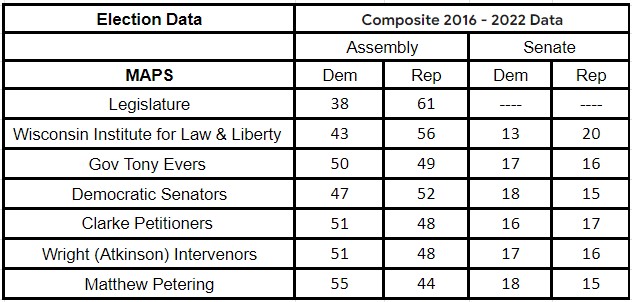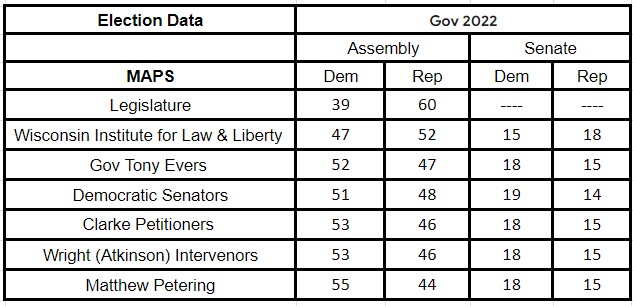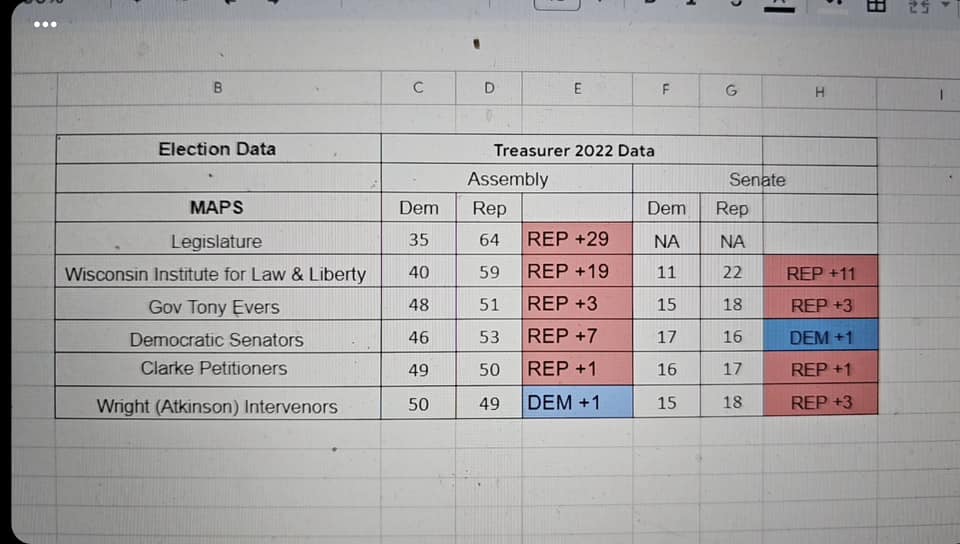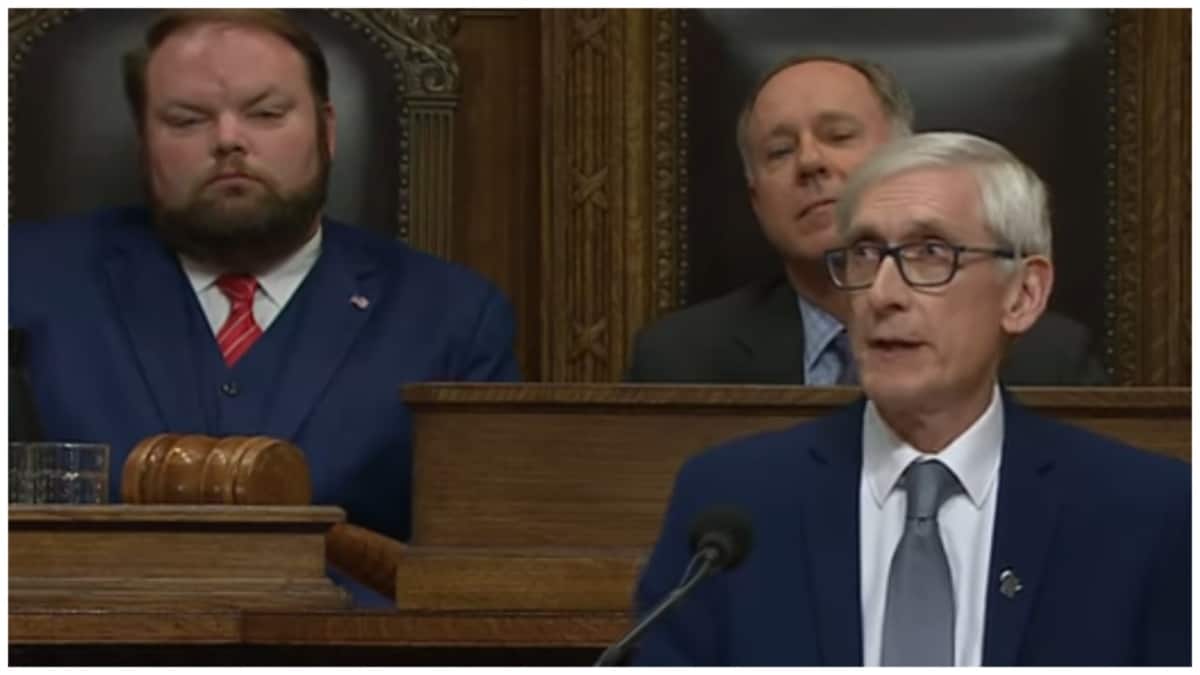Why the heck did the Republican Legislature approve TONY EVERS’ maps? A primer…
We didn’t agree with Republicans in the Legislature voting to approve Evers’ maps (yes, there are a couple tweaks, but they are minimal and just tried to undo some of the unfairness in his maps. They are, for all practical purposes, Evers’ maps.)
We disagreed with this vote because:
- Under multiple credible scenarios, Evers’ maps give control of the Legislature to the Democrats.
2. The maps are horrible on principle. They are terrible partisan gerrymanders that seem designed to screw over Republican incumbents and disenfranchise voters while gaming it for the left. That’s not how this is supposed to work, and it’s not fair. They kick good people out of the Legislature and rob some voters of the chance to vote for a Senator every four years.
3, it’s hard to argue that Evers’ maps are horrible (and they are) when you’re voting for them. It muddles the issue for the public.
Now, due to Evers’ veto (of his almost-own maps, no less!), which was predictable, they’ve only accomplished muddying the narrative.
There were some in the Senate who thought that Evers was negotiating with the Senate and Assembly leadership. It doesn’t appear he ever really was.
That being said, although we would have come down differently, we understand what Assembly Speaker Robin Vos and Senate Leader Devin LeMahieu were doing here. We do not believe they were acting with ill intent (although LeMahieu could have avoided all of this by passing the Iowa model a couple of months ago, so it’s hard to offer him any praise on this.)
With the recent votes on the Evers maps, though, we believe they were trying to mitigate the harm by choosing a slightly less horrible option amidst a sea of horrible options. We think they thought that the rosiest scenarios under Evers’ maps gave them a fighting chance at fairness. Their stance is arguable. We disagree with it. But it’s arguable.
We primarily disagreed with it because Evers’ maps are so awful. Hell no, you don’t put your stamp of approval on them.
They were hinging their argument on the John Leiber race.
Let us explain how this works; it gets complex. When you are reading news outlets saying that this or that map “gives control to the Democrats” or “keeps Republicans in control,” they are basing this on different things. The liberal media are painting this as a simple question; it is not.
The liberal media have all – and we do mean, all – seized on this one obscure research fellow from Marquette’s model. Basically he built a theoretical model to determine this and he built assumptions into it; among them, that he thinks local candidates outperform statewide candidates sometimes (ie some people will vote for their hometown Republican legislator, but they also chose Mandela Barnes or whatever).
His model claims that Republicans would stay in control under almost all the maps (not the Legislature’s or WILL’s, of course.) But some research fellow’s theories are just that. They are theories based on assumptions. We don’t have an issue with the media telling people about John Johnson’s model, although he’s not a professor and his CV does not list a body of impressive election-related work. We have a problem with them acting like it’s the only model, like it’s a fact, and like there are no other ways to do this. And that’s what the media have done. Some have even stated his theories as fact. They are not.
If his theories were right, why would Republicans have voted for Evers’ map? They’d be fine with any map. The truth is, no people behind the scenes think he is right. No one thinks the maps give control to Republicans in most cases. Everyone thinks that the maps drawn by the Senate Democrats, various professors, and the liberal law firm that brought the suit are terrible gerrymanders designed to put Democrats in the majority.
They aren’t just pulling this out of thin air. Behind the scenes, experts use complicated computer programs to analyze this stuff. One of the most respected and common is called Dave’s Redistricting. Most use it. The maps (there were 7, now 6 sets) are imported into it, and you can analyze their impact on the Legislature’s partisan divide by running them against various data sets for different elections.
Let’s explain. To determine the partisan makeup of districts, Dave’s Redistricting runs each map against the partisan breakdowns of each election. Thus, you’d expect that Republicans would have a better chance at control of the Legislature under Eric Toney’s race than Tim Michels’ race. Why? Because Toney was a stronger candidate than Michels. He came closer. That’s how it works.
Forget the other maps for a minute. The Legislature approved Evers’ maps with a few minimal tweaks, and Evers just vetoed them.
- If you run Evers’ maps in Dave’s redistricting, you get the following results.
- If you run them against the 2022 governor’s race, Democrats take control.
- If you run them against the 2022 attorney general’s race, Democrats take control.
- If you run them against a composite of key races from 2016-2022, Democrats take control.
The other maps basically do the same thing and are slightly worse.


If you run the Evers’ maps against Ron Johnson’s victory, Republicans keep control, although they lose a lot of seats, under Evers’ maps. The problem with using that election as a prediction of how the electorate will act in 2024 and 2026 is that Johnson was an incumbent, his race was for control of the Senate and so LOTS of money flooded in (rare Republican not outspent recently), and he ran against a really historically awful opponent, Mandela Barnes. So it’s more tempting to see his race as an outlier. So no one is really using it. Also, it’s federal.
The reason some Republicans decided to push the Evers’ maps is because of the John Leiber race. They think that, using this calculation, Republicans have a chance at fairness (although not a sure thing by any means). Leiber is a Republican who ran statewide in 2022. Republicans keep control of the Legislature under various maps, including Evers, when that election’s data set is used.

Others behind the scenes think it’s really flawed to seize on the Leiber race as some great hopeful predictor of future legislative races.
Those who think it’s a great barometer say it’s clean. There was no incumbent, no one knew who they were, there was minimal spending or ads, and really no one cared about the race. So they think it’s a pure way to measure the electorate’s partisan leaning without any other unique factors (like existed in the Johnson race.)
Those who disagree with this argue that the Leiber race is TOO clean to be a good predictor of how people will choose in legislative races. They point out that Leiber ran for a fiscal position, where voters might prefer a Republican. There was a third-party in the race who siphoned away votes. Leiber did not have to deal with the abortion question or other contentious issues of the day because no one paid attention to the race and it was just for state treasurer. They point out there was minimal spending. In short, they don’t buy it that the Leiber race is a good predictor of whether Evers’ maps give Republicans a realistic chance to stay in control of the Legislature for all of these reasons. Basically no one cared about the Leiber race (sorry John).

The swing legislative races will have major spending and the Democrats will bring up abortion and all kinds of contentious issues.
Maybe the Eric Toney race is a better comparison? He was a good candidate. He ran a good race. He had to deal with abortion and other contentious issues. He ran against an incumbent though and was outspent. But that seems to be the way it’s going in Wisconsin these days. Under Evers’ map and the other Democratic maps, Republicans lose control of the Legislature using the Toney-Kaul race as a barometer.
So that was the calculation. That was the thought process.
It’s also always a gamble to predict future races based on past ones. Turnout will matter. Maybe the electorate’s habits have changed in two years? People are angry at Biden. But there will be a presidential election on the ballot. Fact is, in scenario after scenario, all of the Democratic maps are gamed to flip control to the Democrats. They are partisan gerrymanders. They are not fair. Furthermore, they are trying to rush this through at warp speed. Republicans don’t even know what districts they will be running in next November. We keep hearing that Democrats are already out recruiting candidates to run in various districts.
Why did the Republicans tweak Evers’ maps? Because they are so egregious.
He literally drew incumbents out of their districts by a couple houses in some cases! In some cases, he is disenfranchising Wisconsin voters, who are supposed to be able to vote for a state senator for four years but now have to wait six! He is drawing some legislators out of districts not on the ballot for two years, leaving it an open question whether those voters will have any representation at all! In other words, Republicans took a scalpel to Evers’ maps and tried to fix a couple of the extremely unfair things.
Then, unbelievably, Democratic legislators shrilly shrieked that it was Republicans who were trying to push through a gerrymander. It’s gaslighting to the extreme. We heard the Assembly was going to remove the tweaks. They didn’t end up doing that. We think it’s because they got word that the Senate probably wouldn’t vote it through. Hate to tell you all, but the Republican leadership in the Assembly and Senate don’t get along well and don’t communicate well.
Sigh. Got all this?
The other issue with the Leiber argument is that Evers’ maps did a lot of other horrible things to make it even harder for Republicans to retain control. For example, his maps pit about 35 incumbents against each other, and almost all are Republicans.
That means a lot of good Republicans will be knocked out of the legislature for good under his maps, unless they move. If his maps are fair, why doesn’t he pit more Democrats against each other?
His maps redraw districts to make them more liberal. For example, in the swing 8th Senate district near Milwaukee, he tossed out the super Republican areas of Sussex, Richfield and places like that. He then pitted the Republican incumbent Dan Knodl against another Republican incumbent Duey Stroebel, to either force one out of the Legislature or into a heated and expensive primary.
He did things like this all over the state. In Wausau, he drew a popular incumbent out of the district by a couple houses, leaving an open seat that is almost equally divided. But with an open seat that close, Democrats have a great chance of taking that seat too. Some districts labeled Republican leading in the totals are so close that they are really up for grabs.
Some people think legislative candidates DO perform better than statewide ones, but Evers’ maps egregiously attempt to neutralize any such phenomenon with machinations like the above.
For example, he drew the only black Senate Republican in state history, Julian Bradley, out of his district and stuck him in a district with Republican Van Wanggard. But because the seat isn’t up for two years, Bradley would be forced out of the Legislature unless he moves.
Then Evers has the nerve to argue that his maps are “fair.” Give us a break. Evers claims Republicans want a partisan gerrymander; they are just trying to prevent an egregious Democratic gerrymander. However, the media are giving him cover by misleading readers that the maps give control to Republicans. It’s maddening.
What Happens Next?
What happens next? Republicans are not without options. They just aren’t great ones.
On Feb. 1, two out-of-state consultants who work for universities will recommend maps to the liberal court. They can pick any of the above or draw their own. No one knows what they will do. They were handpicked by the liberals on the court. That doesn’t inspire confidence. However, one upset Democrats in New York with how he draw maps there. So who knows.
The most purely non gerrymandered set of maps in the mix was created by the conservative Wisconsin Institute for Law and Liberty. Their maps come down somewhere in the middle but keep Republicans in control. Maybe, if the consultants are fair, they will pick those.
Why do Republicans control the legislature when Democrats win the state (governor, etc.)? Because Republican voters tend to be spread throughout the state in rural areas and so forth, whereas liberal voters are concentrated in cities. So you’d expect that legislative districts, which exist all throughout the state, would be controlled by more Republicans. To boost their numbers, Democrats needed to create new districts in urban areas.
Liberals argue that the legislative maps should be a perfect representation of the statewide vote. However, this is much like the argument advanced by those who prefer deciding the presidency by the popular vote instead of the electoral college. The electoral college was genius; it ensures that everyone in the country is represented, including voters in rural areas. Otherwise everything would be determined by LA and New York. This is what liberals want in Wisconsin. They want everything to be determined by Milwaukee and Madison, and the concerns of rural Wisconsinites would be largely ignored.
After the consultants propose their maps, the liberal court will either pick what they recommend or draw their own. This is Republicans’ fear. This is an aggressively liberal and partisan court with a new justice who blatantly prejudged the case. It makes a mockery out of our court system. No one, and I mean literally no one, believes the liberal Janet Court will give conservatives a fair hearing on this. No one. The liberals on the court are winning a short-term victory but they are doing egregious harm to our justice system and the public’s faith in this critical institution. There is no sign they care, though.
It’s just a partisan war game.
If they do what is expected and approve an egregious gerrymander to help their friends on the left win control, the next move is to appeal it to the US Supreme Court. Republicans plan to appeal using the Caperton case, which involved recusal due to financial conflict of interest and bias. They are also making a due process argument.
The problem, and this played into the mindset of Vos and LeMahieu, is that the conservative justices (Thomas, Roberts and Alito) dissented in Caperton. They were concerned about mandating recusal based on prediction of bias before it had occurred. However, in this case, Protasiewicz put it on the record. She said the maps were rigged. She also took $10 million from the state Democratic party, which clearly benefits from the gerrymandered maps. However, behind the scenes, Republicans regard the SCOTUS option as a Hail Mary. At the same time, who knows? They kicked Evers’ maps a short time ago on race grounds, and no one expected that.
Some believe that the legislature’s votes on Evers’ maps were kabuki theater designed to strengthen their legal arguments before SCOTUS. The theory goes this makes them look like the reasonable ones. But it also makes it harder for them to argue that Evers’ maps are horrid. After talking to a lot of insiders behind the scenes, we have concluded they were more motivated by the Leiber analysis.
Brief primer; the state Constitution gives authority to the Legislature to redistrict. It’s done every Census (10 years). The Legislature approved maps. Evers vetoed them. So they went into the courts. The liberals on the court plus Brian Hagedorn approved a previous version of Evers’ maps. SCOTUS struck them down, saying they mishandled race. To get before SCOTUS, you need a federal question. Then, because it was close to the election, Hagedorn joined with the conservatives to approve the Legislature’s maps because they offered the least change and the election was close. The second Janet took office, liberals filed yet another lawsuit. The new liberal court at warp speed struck down the Legislature’s maps, saying they improperly included municipal islands. This is a red herring that exposes their partisanship.
That’s because they are just little pieces of annexed land that often have no people living on them. The district borders just kept them in the same municipalities that had annexed them because the Constitution also says that municipal and county boundaries should be generally left intact. The liberals on the court and Evers were fine with municipal islands a year ago. Now they’re suddenly unconstitutional! The court asked interested parties to submit maps. Seven were submitted. One was Evers’. One was the Legislature’s. One was WILL’s. The others are Democratic. The Legislature just dissolved the supposedly problematic municipal islands into surrounding districts.
Not good enough said Evers! He had to make sure to draw incumbents out of their districts by a couple houses! What does that have to do with municipal islands anyway…
So that’s where it’s at. And that’s why we disagreed with the Legislature’s votes, but we understand what Vos and Lemahieu were trying to do. They had a rational argument. It wasn’t a great one, but there are zero good options here.
However, they’ve drop-kicked the narrative. It’s a little hard to argue how bad Evers’ maps are when they just voted for them. We will continue educating the public on what his maps do. We are consistent. We’ve never not said they were horrible. They’re horrible because they exhibit extreme partisan game playing with an important legislative process. They are not fair. None of this is.
On another front, the Republicans in the state Senate could have stopped all of this. Back in September, Vos proposed that maps be drawn using a non-partisan Iowa model. This was better than any of the maps proposed by Democrats now because the non partisan Legislative Reference Bureau would have drawn them and the Legislature would have had veto power (no shocker since the Constitution gives the Legislature redistricting authority.) Vos actually wrangled three Democratic votes; he had enough votes to override an Evers veto (even though Evers was previously for the Iowa model).
Guess what happened? For reasons no one can clearly explain, the plan got bottled up in a state Senate committee after passing the Assembly and it never saw the light of day. And that falls on LeMahieu, the Republican Senate leader, who should have made sure it did.
There are other bad decisions that brought us to this point. The decision of Dan Kelly to run a second time among them. Jennifer Dorow was the better candidate. The Michels’ loss was hugely consequential.
We thought we would offer this primer because it’s a complicated issue, but it’s very important. If Democrats get control of the legislature, we will be like Minnesota or California. Look to our neighbors in Minnesota if you want to understand the high stakes at play here.
Table of Contents





![Mandela Barnes Said ‘Reducing Prison Populations is Now Sexy’ [VIDEO] Reducing Prison Populations is Now Sexy](https://www.wisconsinrightnow.com/wp-content/uploads/2022/09/Collage-Maker-14-Sep-2022-11.44-AM-265x198.jpg)






